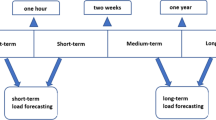Abstract
In this paper a load forecasting methodology for 2 days-ahead based on functional clustering and on ensemble learning is presented. Due to the longitudinal nature of the load diagrams, these are segmented using a functional clustering procedure to group together similar daily load curves concerning its phase and amplitude. Next, ensemble learning of extreme learning machine models, developed for several load curves groups, is made to fully integrate the advantages of all models and improve the accuracy of the final load forecasting. The quality of this methodology is illustrated with a real case study concerning load consumption patterns of clients with different economic activities from a Portuguese energy trading company. The forecasting results for 2 days-ahead are good for practical use, yielding a \(R^{2} = 0.967\).





Similar content being viewed by others
References
Feinberg EA, Genethliou D (2005) Load forecasting. In: Applied mathematics for restructured electric power systems. Springer, pp 269–285
Suganthi L, Samuel AA (2012) Energy models for demand forecasting a review. Renew Sustain Energy Rev 16(2):1223–1240
Alfares HK, Nazeeruddin M (2002) Electric load forecasting: literature survey and classification of methods. Int J Syst Sci 33(1):23–34
Metaxiotis K, Kagiannas A, Askounis D, Psarras J (2003) Artificial intelligence in short term electric load forecasting: a state-of-the-art survey for the researcher. Energy Convers Manag 44(9):1525–1534
Badar-Ul-Islam E, Qureshi SA (2011) Comparison of conventional and modern load forecasting techniques based on artificial intelligence and expert systems. Int J Comput Sci 8(5):28–37
Liao TW (2005) Clustering of time series data a survey. Pattern Recognit 38(11):1857–1874
Jacques J, Preda C (2014) Functional data clustering: a survey. Adv Data Anal Classif 8(3):231–255
Goia A, May C, Fusai G (2010) Functional clustering and linear regression for peak load forecasting. Int J Forecast 26(4):700–711
Antoch J, Prchal L, de Rosa MR, Sarda P (2008) Functional linear regression with functional response: application to prediction of electricity consumption. In: Functional and operatorial statistics. Springer, pp 23–29
Cheng Q, Yao J, Wu H, Chen S, Liu C, Yao P (2013) Short-term load forecasting with weather component based on improved extreme learning machine. In: Chinese Automation Congress (CAC). IEEE, pp 316–321
Matijaš M, Suykens JA, Krajcar S (2013) Load forecasting using a multivariate meta-learning system. Expert Syst Appl 40(11):4427–4437
Kaur A, Pedro HT, Coimbra CF (2014) Ensemble re-forecasting methods for enhanced power load prediction. Energy Convers Manag 80:582–590
Slaets L, Claeskens G, Hubert M (2012) Phase and amplitude-based clustering for functional data. Comput Stat Data Anal 56(7):2360–2374
Genolini C, Falissard B (2010) KmL: k-means for longitudinal data. Comput Stat 25(2):317–328
Caliński T, Harabasz J (1974) A dendrite method for cluster analysis. Commun Stat Theory Methods 3(1):1–27
Ray S, Turi RH (1999) Determination of number of clusters in k-means clustering and application in colour image segmentation. In: Proceedings of the 4th international conference on advances in pattern recognition and digital techniques, Calcutta, India, pp 137–143
Davies DL, Bouldin DW (1979) A cluster separation measure. IEEE Trans Pattern Anal Mach Intell 2:224–227
Huang G-B, Zhu Q-Y, Siew C-K (2006) Extreme learning machine: theory and applications. Neurocomputing 70(1):489–501
Rao CR, Mitra SK (1971) Generalized inverse of matrices and its applications, vol 7. Wiley, New York
Bishop CM et al (2006) Pattern recognition and machine learning, vol 4. Springer, New York
Trindade A (2015) UCI machine learning repository. http://archive.ics.uci.edu/ml/datasets/ElectricityLoadDiagrams20112014
Genolini C, Alacoque X, Sentenac M, Arnaud C (2015) kml and kml3d: R packages to cluster longitudinal data. J Stat Software 65(4):1–34. http://www.jstatsoft.org/v65/i04/
Han J, Kamber M (2006) Data mining: concepts and techniques. Morgan Kaufmann, Burlington
Taylor JW, Buizza R (2003) Using weather ensemble predictions in electricity demand forecasting. Int J Forecast 19(1):57–70
Fan S, Chen L, Lee W-J (2008) Short-term load forecasting using comprehensive combination based on multi-meteorological information. In: IEEE/IAS industrial and commercial power systems technical conference. IEEE, pp 1–7
Taylor JW, Buizza R (2002) Neural network load forecasting with weather ensemble predictions. IEEE Trans Power Syst 17(3):626–632
López M, Valero S, Senabre C, Aparicio J, Gabaldón A (2011) Development of a model for short-term load forecasting with neural networks and its application to the electrical Spanish market. In: 8th international conference on the European Energy Market (EEM). IEEE, pp 321–326
Llanos J, Saez D, Palma-Behnke R, Nunez A, Jimenez-Estevez G (2012) Load profile generator and load forecasting for a renewable based microgrid using self organizing maps and neural networks. In: The 2012 international joint conference on neural networks (IJCNN). IEEE, pp 1–8
Acknowledgements
The authors would like to acknowledge the support by FEDER Funds through the program “Operacional Regional do Norte - Concurso 07/SI/2012” under the project Ferramenta de Gestão para a Aquisição de Electricidade nos Mercados Grossistas OMIP e OMIE (WATTUP-2013-04/2014).
Author information
Authors and Affiliations
Corresponding author
Rights and permissions
About this article
Cite this article
Rodrigues, F., Trindade, A. Load forecasting through functional clustering and ensemble learning. Knowl Inf Syst 57, 229–244 (2018). https://doi.org/10.1007/s10115-018-1169-y
Received:
Revised:
Accepted:
Published:
Issue Date:
DOI: https://doi.org/10.1007/s10115-018-1169-y




